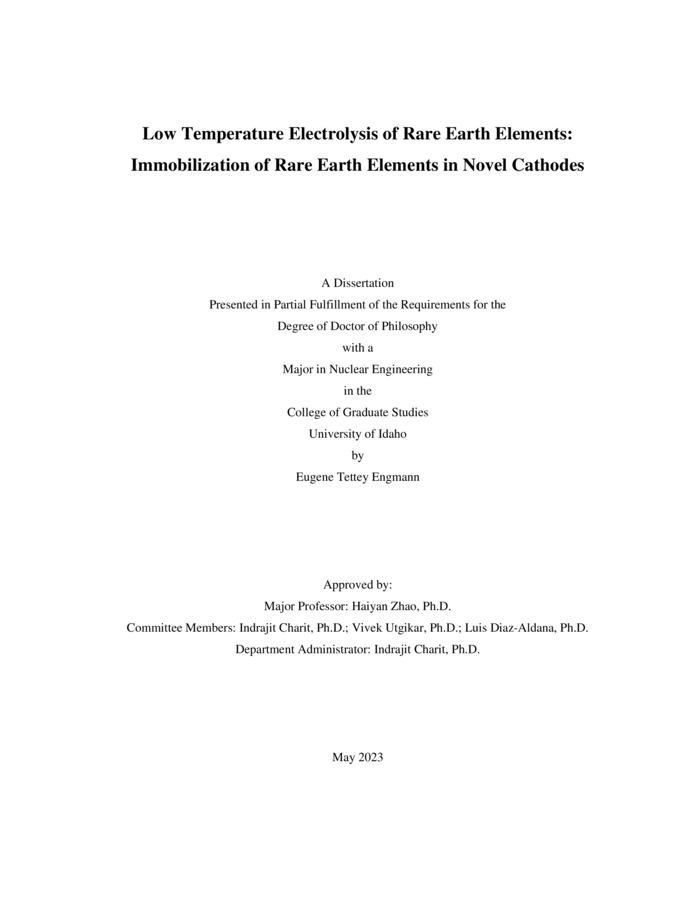Low Temperature Electrolysis of Rare Earth Elements: Immobilization of Rare Earth Elements in Novel Cathodes
Engmann, Eugene. (2023-05). Low Temperature Electrolysis of Rare Earth Elements: Immobilization of Rare Earth Elements in Novel Cathodes. Theses and Dissertations Collection, University of Idaho Library Digital Collections. https://www.lib.uidaho.edu/digital/etd/items/engmann_idaho_0089e_12566.html
- Title:
- Low Temperature Electrolysis of Rare Earth Elements: Immobilization of Rare Earth Elements in Novel Cathodes
- Author:
- Engmann, Eugene
- Date:
- 2023-05
- Embargo Remove Date:
- 2023-12-08
- Program:
- Nuclear Engr & Industrial Mgmt
- Subject Category:
- Chemical engineering
- Abstract:
-
The electrochemical immobilization of rare earth elements (REEs) provides a promising approach for retrieving REEs from mining ores and end-of-life products (recyclability). Conventional methods such as solvents extraction, ion exchange, and molten salt reduction have proven to be effective ways of extracting REEs but consume lots of energy or chemicals or both. Furthermore, during application of these conventional approaches, there is degradation of the anode and electrolyte. An alternative and promising pathway for REEs capture is low temperature (< 40 °C) electrochemical immobilization of REEs using metal and metal oxides in aqueous solution. The use of metal oxide lies in the fact that the disproportionation reaction of some metal oxides such as Ga2O, can entrain metal ions of interest (a novel approach being investigated for REE capture.) from aqueous solution. On the other hand, certain metal oxides such as MnO2, MoS2 or graphite base materials provide weaker van der Waal gaps between atomic lattices to host potential metal ions such as REEs (another novel approach). This approach addresses several gaps and overcomes disadvantages of current conventional methods such as high temperature, large amount of chemical exhaustion, anode degradation, high safety risk and hazard prone environments.My Ph.D. work seeks to investigate two methods for REEs immobilization. The first is the electrochemical formation of REE alloys. This would employ a non-toxic low temperature melting metal, Ga as cathode. The electrochemistry of the REE, Pr, will be investigated at a liquid Ga cathode to study the possibility of Pr deposition on the Ga cathode. Alloy formation will also harness the disproportionation of Ga oxide for the entrainment of REEs. Secondly, immobilization of REEs into metal oxides via pseudo-intercalation and pseudo-capacitance will be investigated and studied. Intercalation will take advantage of the weaker van der Waal forces between the gaps of the atomic lattices of certain metal oxides for the possible capture of REEs. Electrochemical techniques such as cyclic voltammetry and chronoamperometry are employed to evaluate various cathodic materials including Ga, MnO2, MoS2 and turbostratic carbon (Vulcan XC72R). This work will focus on the REEs Pr and Nd. Electrochemistry measurements will be performed, taking into account REE concentration, metal oxide loading capacities, and reduction potentials. Following initial experimentation, it was observed that REEs were immobilized into various cathodes. These results are encouraging for the recovery of REEs using low temperature electrochemical reduction beyond established methods
- Description:
- doctoral, Ph.D., Nuclear Engr & Industrial Mgmt -- University of Idaho - College of Graduate Studies, 2023-05
- Major Professor:
- Zhao, Haiyan
- Committee:
- Zhao, Haiyan; Charit, Indrajit; Utgikar, Vivek; Diaz, Luis
- Defense Date:
- 2023-05
- Identifier:
- Engmann_idaho_0089E_12566
- Type:
- Text
- Format Original:
- Format:
- application/pdf
- Rights:
- In Copyright - Educational Use Permitted. For more information, please contact University of Idaho Library Special Collections and Archives Department at libspec@uidaho.edu.
- Standardized Rights:
- http://rightsstatements.org/vocab/InC-EDU/1.0/

